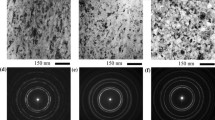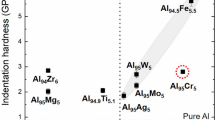Abstract
Ascertaining the mechanism(s) of nanocrystalline stability is a critical need in revealing how specific alloys retard grain growth. Often significant debate exists concerning such mechanisms, even in the same alloy. Here, we compare two processing methods—high-energy ball milling and thin film deposition—in the fabrication and subsequent two-step annealing (500 °C/24 h followed by a temperature ramp to 900 °C whereupon the sample was held for 1 min and quenched) for nanocrystalline Cu–Zr. Using precession electron diffraction (PED) and atom probe tomography (APT), the grain stability and secondary phase content was quantified. The milled powder sample revealed that the Zr solute was largely in an oxide/carbide state after milling with no significant change upon annealing. In contrast, the thin film sample showed nearly all elemental Zr upon deposition but significant oxidation after the vacuum anneal. The significant uptake of oxygen is contributed to the high surface area-to-volume ratio of the film coupled with columnar grains that were enriched in elemental Zr in the as-deposited state. Furthermore, upon sputter deposition, many of these boundaries were vitrified which was lost upon annealing. These glassy boundaries were not observed by PED of the powders. The consequence of when the solute reacts with contaminate species is discussed in relation to nanocrystalline and microstructural stability. The use of Zener pinning predicted grain sizes, based on the quantification of the secondary phase particulates measured by APT, are given to better ascertain their contribution to nanocrystalline stability.
Graphic abstract














Similar content being viewed by others
References
Zhu YT, Liao XZ, Wu XL (2012) Deformation twinning in nanocrystalline materials. Prog Mater Sci 57(1):1–62
Li HQ, Choo H, Ren Y, Saleh TA, Lienert U, Liaw PK, Ebrahimi F (2008) Strain-dependent deformation behavior in nanocrystalline metals. Phys Rev Lett 101(1):015502
Sanders PG, Eastman JA, Weertman JR (1997) Elastic and tensile behavior of nanocrystalline copper and palladium. Acta Mater 45(10):4019–4025
Lu L, Sui ML, Lu K (2000) Superplastic extensibility of nanocrystalline copper at room temperature. Science 287:1463–1466
Liddicoat PV, Liao XZ, Zhao Y, Zhu Y, Murashkin MY, Lavernia EJ, Valiev RZ, Ringer SP (2010) Nanostructural hierarchy increases the strength of aluminium alloys. Nat Commun 1:63
Rupert TJ, Schuh CA (2010) Sliding wear of nanocrystalline Ni–W: structural evolution and the apparent breakdown of Archard scaling. Acta Mater 58(12):4137–4148
Darling K, Rajagopalan M, Komarasamy M, Bhatia M, Hornbuckle B, Mishra R, Solanki K (2016) Extreme creep resistance in a microstructurally stable nanocrystalline alloy. Nature 537(7620):378–381
Gleiter H (1989) Nanocrystalline materials. Prog Mater Sci 33(4):223–315
Andrievski RA (2014) Review of thermal stability of nanomaterials. J Mater Sci 49(4):1449–1460. https://doi.org/10.1007/s10853-013-7836-1
Tschopp MA, Murdoch HA, Kecskes LJ, Darling KA (2014) “Bulk” nanocrystalline metals: review of the current state of the art and future opportunities for copper and copper alloys. JOM 66(6):1000–1019
Weissmüller J (1993) Alloy effects in nanostructures. Nanostruct Mater 3:261–272
Chookajorn T, Murdoch HA, Schuh CA (2012) Design of stable nanocrystalline alloys. Science 337(6097):951–954
Nes E, Ryum N, Hunderi O (1985) On the zener drag. Acta Metall 33(1):11–22
Krill CE, Ehrhardt H, Birringer R (2005) Thermodynamic stabilization of nanocrystallinity. Z Metallkd 96(10):1134–1141
Darling KA, VanLeeuwen BK, Koch CC, Scattergood RO (2010) Thermal stability of nanocrystalline Fe–Zr alloys. Mater. Sci. Eng. A 527(15):3572–3580
Darling KA, Kecskes LJ, Atwater M, Semones J, Scattergood RO, Koch CC (2013) Thermal stability of nanocrystalline nickel with yttrium additions. J Mater Res 28(13):1813–1819
Atwater MA, Roy D, Darling KA, Butler BG, Scattergood RO, Koch CC (2012) The thermal stability of nanocrystalline copper cryogenically milled with tungsten. Mater. Sci. Eng. A 558:226–233
Amram D, Schuh CA (2018) Interplay between thermodynamic and kinetic stabilization mechanisms in nanocrystalline Fe–Mg alloys. Acta Mater 144:447–458
Murdoch HA, Schuh CA (2013) Stability of binary nanocrystalline alloys against grain growth and phase separation. Acta Mater 61(6):2121–2132
Darling KA, Tschopp MA, VanLeeuwen BK, Atwater MA, Liu ZK (2014) Mitigating grain growth in binary nanocrystalline alloys through solute selection based on thermodynamic stability maps. Comput Mater Sci 84:255–266
Koju RK, Darling KA, Kecskes LJ, Mishin Y (2016) Zener pinning of grain boundaries and structural stability of immiscible alloys. JOM 68(6):1596–1604
Manohar PA, Ferry M, Chandra T (1998) Five decades of the zener equation. ISIJ Int 38(9):913–924
Doherty RD (2012) Grain coarsening—insights from curvature modeling cyril stanley smith lecture. Mater Sci Forum 715–716:1–12
Cantwell PR, Tang M, Dillon SJ, Luo J, Rohrer GS, Harmer MP (2014) Grain boundary complexions. Acta Mater 62:1–48
Dillon SJ, Tang M, Carter WC, Harmer MP (2007) Complexion: a new concept for kinetic engineering in materials science. Acta Mater 55(18):6208–6218
Koju RK, Darling KA, Solanki KN, Mishin Y (2018) Atomistic modeling of capillary-driven grain boundary motion in Cu–Ta alloys. Acta Mater 148:311–319
Rajagopalan M, Darling K, Turnage S, Koju RK, Hornbuckle B, Mishin Y, Solanki KN (2017) Microstructural evolution in a nanocrystalline Cu–Ta alloy: a combined in situ TEM and atomistic study. Mater Des 113:178–185
Kapoor M, Kaub T, Darling KA, Boyce BL, Thompson GB (2017) An atom probe study on Nb solute partitioning and nanocrystalline grain stabilization in mechanically alloyed Cu–Nb. Acta Mater 126:564–575
Atwater MA, Scattergood RO, Koch CC (2013) The stabilization of nanocrystalline copper by zirconium. Mater. Sci. Eng. A 559:250–256
Khalajhedayati A, Rupert TJ (2015) High-temperature stability and grain boundary complexion formation in a nanocrystalline Cu–Zr alloy. JOM 67(12):2788–2801
Khalajhedayati A, Pan ZL, Rupert TJ (2016) Manipulating the interfacial structure of nanomaterials to achieve a unique combination of strength and ductility. Nat Commun 7:10802
Schuler JD, Rupert TJ (2017) Materials selection rules for amorphous complexion formation in binary metallic alloys. Acta Mater 140:196–205
Zhao JT, Zhang JY, Cao LF, Wang YQ, Zhang P, Wu K, Liu G, Sun J (2017) Zr alloying effect on the microstructure evolution and plastic deformation of nanostructured Cu thin films. Acta Mater 132:550–564
Almyras GA, Matenoglou GM, Komninou P, Kosmidis C, Patsalas P, Evangelakis GA (2010) On the deposition mechanisms and the formation of glassy Cu–Zr thin films. J Appl Phys 107(8):084313
Marvel CJ, Yin D, Cantwell PR, Harmer MP (2016) The influence of oxygen contamination on the thermal stability and hardness of nanocrystalline Ni–W alloys. Mater. Sci. Eng. A 664:49–57
Marvel CJ, Cantwell PR, Harmer MP (2015) The critical influence of carbon on the thermal stability of nanocrystalline Ni–W alloys. Scr Mater 96:45–48
Baker FB, Storms EK, Holley CE (1969) Enthalpy of formation of zirconium carbide. J Chem Eng Data 14(2):244–246
Chase MW Jr (1998) NIST-JANAF thermochemical tables, 4th edn. American Chemical Society, Woodbury, NY
Kelly TF, Miller MK (2007) Atom probe tomography. Rev Sci Instrum 78(3):031101
Guo W, Jagle EA, Choi PP, Yao JH, Kostka A, Schneider JM, Raabe D (2014) Shear-induced mixing governs codeformation of crystalline-amorphous nanolaminates. Phys Rev Lett 113(3):035501
Guo W, Yao J, Jägle EA, Choi P-P, Herbig M, Schneider JM, Raabe D (2015) Deformation induced alloying in crystalline—metallic glass nano-composites. Mater Sci Eng A 628:269–280
Guo W, Gan B, Molina-Aldareguia JM, Poplawsky JD, Raabe D (2016) Structure and dynamics of shear bands in amorphous-crystalline nanolaminates. Scr Mater 110:28–32
Zhou X, Yu X-X, Kaub T, Martens RL, Thompson GB (2016) Grain boundary specific segregation in nanocrystalline Fe(Cr). Sci Rep 6:34642
Moeck P, Rouvimov S, Rauch EF, Véron M, Kirmse H, Häusler I, Neumann W, Bultreys D, Maniette Y, Nicolopoulos S (2011) High spatial resolution semi-automatic crystallite orientation and phase map** of nanocrystals in transmission electron microscopes. Cryst Res Technol 46(6):589–606
Rauch EF, Portillo J, Nicolopoulos S, Bultreys D, Rouvimov S, Moeck P (2010) Automated nanocrystal orientation and phase map** in the transmission electron microscope on the basis of precession electron diffraction. Z Kristallogr 225(2–3):103–109
Brons J, Thompson G (2014) Orientation map** via precession-enhanced electron diffraction and its applications in materials science. JOM 66(1):165–170
Thompson K, Lawrence D, Larson DJ, Olson JD, Kelly TF, Gorman B (2007) In situ site-specific specimen preparation for atom probe tomography. Ultramicroscopy 107(2–3):131–139
Hornbuckle B, Kapoor M, Thompson G (2015) A procedure to create isoconcentration surfaces in low-chemical-partitioning, high-solute alloys. Ultramicroscopy 159:346–353
Barton DJ, Hornbuckle BC, Darling KA, Thompson GB (2019) The influence of isoconcentration surface selection in quantitative outputs from proximity histograms. Microsc Microanal 25:401–409
Commercial product—Silicon half grids. http://www.microscopyconsumables.com/product-p/grd-0002.04.10.htm.
Zhou X, Thompson GB (2019) Charge-state field evaporation behavior in Cu(V) nanocrystalline alloys. Microsc Microanal 25:501–510
Grigorian CM, Rupert TJ (2019) Thick amorphous complexion formation and extreme thermal stability in ternary nanocrystalline Cu–Zr–Hf alloys. Acta Mater 179:172–182
Zhou X, Kaub T, Martens RL, Thompson GB (2016) Influence of Fe(Cr) miscibility on thin film grain size and stress. Thin Solid Films 612(1):29–35
Gungor A, Barmak K, Rollett AD, Cabral Jr C, Harper JME (2002) Texture and resistivity of dilute binary Cu(Al), Cu(In), Cu(Ti), Cu(Nb), Cu(Ir), and Cu(W) alloy thin films. J Vac Sci Technol B 20(6):2314–2319
Sterwerf C, Kaub T, Deng C, Thompson GB, Li L (2017) Deformation mode transitions in amorphous-Cu45Zr55/crystalline-Cu multilayers. Thin Solid Films 626:184–189
Zhou X, Thompson GB (2019) In situ TEM observations of initial oxidation behavior in Fe-rich Fe–Cr alloys. Surf Coat Technol 357:332–338
Acknowledgements
XZ and GBT gratefully acknowledge NSF-DMR-1709803 for support of this research, which involved the characterization and analysis of the APT datasets. JS, CG, and TJR acknowledge the U.S. Army Research Office under Grant W911NF-16-1-0369 for the specimens and technical discussion. LL recognizes US National Science Foundation under Grant CMMI 17-0267 for technical discussion in the implication of the findings on phase stability. The UA Central Analytical Facility is recognized for additional assistance and access to the microscopes used in this research.
Author information
Authors and Affiliations
Corresponding author
Additional information
Handling Editor: Nathan Mara.
Publisher's Note
Springer Nature remains neutral with regard to jurisdictional claims in published maps and institutional affiliations.
Appendix
Appendix
The appendix section provides additional information concerning the sampling sizes for the grain size analysis of each of the samples. Referring to Table 2, the number of grains were randomly reduced to determine if the error and/or average value changed. This has been plotted for the average value, and its standard deviation, in Fig. 14, with the cumulative area fractions in Fig. 15.
Plot of average grain size and one standard deviation by the random reduction of grain sizes from the total number of grain counted given in Table 2. Note the relative invariance of the average and error, indicating that the grain size deviation about the average is intrinsic to the processed microstructure and not a result of low counting statistics
Cumulative area fraction maps with a random reduction of the counted grain sizes given in Table 2. This absent or near modest changes with reduced number of counted grains confirms that the standard deviation about the averaged reported in the paper and in Fig. 14 is intrinsic to the processed microstructure and not a result of low counting statistics
Rights and permissions
About this article
Cite this article
Zhou, X., Schuler, J.D., Grigorian, C.M. et al. Influence and comparison of contaminate partitioning on nanocrystalline stability in sputter-deposited and ball-milled Cu–Zr alloys. J Mater Sci 55, 16758–16779 (2020). https://doi.org/10.1007/s10853-020-05135-y
Received:
Accepted:
Published:
Issue Date:
DOI: https://doi.org/10.1007/s10853-020-05135-y






